Fred Rogers
| Fred Rogers | |
|---|---|
 Rogers in 1986 | |
| Born |
Fred McFeely Rogers March 20, 1928 Latrobe, Pennsylvania, U.S. |
| Died |
February 27, 2003 (aged 74) Pittsburgh, Pennsylvania, U.S. |
| Other names | Mister Rogers |
| Alma mater |
Dartmouth College (attended) Rollins College (BA, 1951) Pittsburgh Theological Seminary (M.Div.) |
| Occupation | Children's television presenter, actor, puppeteer, singer, composer, television producer, author, educator, Presbyterian minister |
| Years active | 1951–2001 |
| Spouse(s) |
Joanne Byrd (m. 1952) |
| Children | 2 |
| Official name | Fred McFeely Rogers (1928–2003) |
| Type | Roadside |
| Designated | June 25, 2016 |
| Signature | |
|
| |
Fred McFeely Rogers (March 20, 1928 – February 27, 2003) was an American television personality, musician, puppeteer, writer, producer, and Presbyterian minister. He was known as the creator, composer, producer, head writer, showrunner and host of the preschool television series Mister Rogers' Neighborhood (1968–2001). The show featured Rogers's kind, neighborly, avuncular persona,[1] which nurtured his connection to the audience.[2]
Trained and ordained as a minister, Rogers was displeased with the way television addressed children at the time; he began to write and perform local Pittsburgh-area shows for youth. In 1968, Eastern Educational Television Network began nationwide distribution of Rogers's new show on WQED. Over the course of three decades, Rogers became a television icon of children's entertainment and education.[3]
Rogers advocated various public causes. On the Betamax case, the U.S. Supreme Court cited Rogers's prior testimony before a lower court in favor of fair-use television show recording (now called time shifting). Rogers also gave a testimony, now famous, advocating the government funding of children's television before a U.S. Senate committee.[4]
Rogers received the Presidential Medal of Freedom, 40 honorary degrees,[5] and a Peabody Award. He was inducted into the Television Hall of Fame and was recognized in two congressional resolutions. He was ranked number 35 of the TV Guide's Fifty Greatest TV Stars of All Time.[6] Several buildings and artworks in Pennsylvania are dedicated to his memory, and the Smithsonian Institution displays one of his trademark sweaters as a "Treasure of American History". On June 25, 2016, the Fred Rogers Historical Marker was placed near Latrobe, Pennsylvania in his memory.[7]
Early and personal life
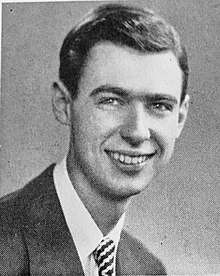
Rogers was born to James and Nancy Rogers 40 miles (65 km) southeast of Pittsburgh in Latrobe, Pennsylvania. He had a sister, Elaine.[8] The young Fred Rogers spent his free time with his maternal grandfather Fred McFeely, who was interested in music; Rogers began to play the piano when he was five and sang along when his mother played.[5] He acquired a piloting license in high school[9][10] and was a lifelong Republican.[11][12]
Rogers attended Latrobe High School and was very active in extracurricular activities. Rogers served as president of the student council, a member of the National Honor Society and was editor-in-chief of the yearbook; he graduated in 1946.[13][14] He studied at Dartmouth College from 1946 until 1948[15] and then went on at Rollins College in Winter Park, Florida to earn a BA in music composition in 1951.[16][12] At Rollins, he met Oakland, Florida native Sara Joanne Byrd, born c. 1928;[17] the two got married on June 9, 1952.[18] They had two sons: James, in 1959, and John, in 1961.[19] Rogers graduated from Pittsburgh Theological Seminary and was ordained a minister of the United Presbyterian Church in 1963.[20] Rogers returned to Pittsburgh in the 1960s and attended the Sixth Presbyterian Church, in the Squirrel Hill neighborhood.[21] Rogers had an apartment in New York City and a summer home on Nantucket Island in Massachusetts.[19][22]
Rogers was red–green color blind.[23] He swam every morning and neither smoked nor drank.[24] He became a vegetarian in his mid–40s, stating "I don't want to eat anything that has a mother."[25] Contrary to rumor, he never served in the military.[26][27][28] Rogers' office at WQED Pittsburgh had only a sofa and armchairs because Rogers thought a desk was "too much of a barrier".[29]
Rogers greatly enjoyed the 1994 film Forrest Gump, which his son said Rogers viewed "probably a hundred times."[30]
Television career
|
|
Early work
Rogers entered seminary after college but wanted to work with television.[22] In an interview with CNN, Rogers said, "I went into television because I hated it so, and I thought there's some way of using this fabulous instrument to nurture those who would watch and listen."[24] He applied for a job at NBC in New York City in 1951 and worked first as an assistant producer, and later, network floor director on musical programs including Your Hit Parade, The Kate Smith Hour, and The Voice of Firestone.[20][31] He also worked on Gabby Hayes's children's show.
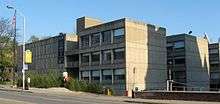
Rogers decided that television's reliance on advertisement and merchandising kept it from educating young audiences; he left NBC and began working as a puppeteer on the local children's show The Children's Corner for Pittsburgh public television station WQED in 1954. He worked with host Josie Carey on unscripted live TV for the next seven years to develop the puppets, characters, and music—including King Friday XIII and X the Owl—that he used in his own work later.[32] He voice acted King Friday XIII, Queen Sara Saturday (named after his wife), X the Owl, Henrietta Pussycat, Daniel Stripèd Tiger, Lady Elaine Fairchilde, and Larry Horse. The show won a Sylvania Award[33] for best children's show and was broadcast nationally on NBC. Rogers began wearing his famous sneakers on set when he noticed that they were quieter than his work shoes. Rogers studied theology at the nearby Pittsburgh Theological Seminary during his lunch breaks; however, he was uninterested in preaching and was told to continue making children's television after his ordination.[34] He worked with the University of Pittsburgh's child development and care program.
In 1963, the Canadian Broadcasting Corporation (CBC) contracted Rogers to develop the 15-minute children's program Misterogers,[35] which would have only three seasons despite its popularity among children; Rogers moved to Toronto. CBC designed many of his famous set pieces: the Trolley, the Eiffel Tower, the "tree", and the "castle". Rogers brought his friend and understudy Ernie Coombs from Mister Rogers' Neighborhood to Misterogers as a puppeteer and voice actor. When Rogers returned to the United States, Coombs remained in Canada and was cast for CBC's Butternut Square, which replaced Misterogers, on CBC TV between October 19, 1964, and February 10, 1967. Coombs later made another CBC TV children's show, Mr. Dressup, which ran from 1967 to 1996. Mr. Dressup used songs that were featured on Rogers's programs later.
In 1966, Rogers got the rights to his program from the CBC and moved the show to WQED in Pittsburgh, where he had worked on The Children's Corner. He developed the new show for the Eastern Educational Network. Few stations carried the program, though some were in Boston, Washington, DC, and New York City.
Distribution of Mister Rogers' Neighborhood began on February 19, 1968. In 1970, the show moved to PBS (Public Broadcasting Service). In 1971, Rogers formed Family Communications, Inc. (FCI), and the company took office in the WQED building in Pittsburgh. The company first produced only Mister Rogers' Neighborhood but now develops and produces other children's programs and educational materials.
Mister Rogers' Neighborhood
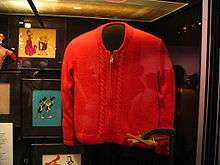
Mister Rogers' Neighborhood began airing in 1968 and ran for 895 episodes. The last set of new episodes was taped in December 2000 and began airing in August 2001. At its peak, in 1985, eight percent of US households tuned into the show.[5]
- Each episode began the same way: Mister Rogers is seen coming home, singing his theme song "Won't You Be My Neighbor?", and changing into sneakers and a zippered cardigan sweater (he stated in an interview for Emmy TV that all of his sweaters were knitted by his mother).[36]
- In a typical episode, Rogers might have an earnest conversation with his television audience, interact with live guests, take a field trip to such places as a bakery or a music store, or watch a short film.
- Typical video subjects included demonstrations of how mechanical objects work, such as bulldozers, or how things are manufactured, such as crayons.
- Each episode included a trip to Rogers' "Neighborhood of Make-Believe" featuring a trolley with its own chiming theme song, a castle, and the kingdom's citizens, including King Friday XIII. The subjects discussed in the Neighborhood of Make-Believe often allowed further development of themes discussed in Mister Rogers' "real" neighborhood.
- Mister Rogers often fed his aquarium fish during episodes.
- Typically, each week's episode explored a major theme, such as going to school for the first time.
- At the outset, most episodes ended with a song entitled "Tomorrow", and Friday episodes looked forward to the week ahead with an adapted version of "It's Such a Good Feeling". In later seasons, all episodes ended with "Feeling".
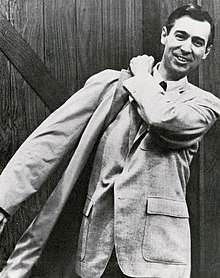
Visually, the presentation of the show was very simple, and it did not feature the animation or fast pace of other children's shows, which Rogers thought of as "bombardment".[4] Rogers also believed in not acting out a different persona on camera compared to how he acted off camera, stating that "One of the greatest gifts you can give anybody is the gift of your honest self. I also believe that kids can spot a phony a mile away."[37] Rogers composed almost all of the music on the program. The recurring songs were all Rogers' work. Bits of incidental music, such as improvisations from members of the orchestra or music from guests to the program, were not composed by Rogers. He wanted to teach children to love themselves and others, and he addressed common childhood fears with comforting songs and skits. For example, one of his famous songs explains how a child cannot be sucked down the bathtub drain as he or she will not fit. He once took a trip to the Children's Hospital of Pittsburgh to show children that a hospital is not a place to fear. During the Gulf War (1990–91), he assured his audience that all children in the neighborhood would be well cared for and asked parents to promise to take care of their children. The message was aired again by PBS during the media storm that preceded the 2003 invasion of Iraq.
Other television work
In 1994, Rogers created a one-time special for PBS called Fred Rogers' Heroes, which consisted of documentary portraits of four persons whose work helped make their communities better. Rogers, uncharacteristically dressed in a suit and tie, hosted the show in wraparound segments that did not use the "Neighborhood" set.
For a time, Rogers produced specials for parents as a precursor to the "Subject of the Week" segment on the Neighborhood called "Mister Rogers Talks To Parents about ...". Rogers didn't host those specials, but instead invited news announcers, such as Joan Lunden (who hosted the Conflict special), to take on the emcee duties in front of a gallery of parents while Rogers answered questions from them. These specials were made to prepare parents for questions their children might ask after watching the episodes on the topic of the week.
The only time Rogers appeared on television as someone other than himself was in 1996 when he played a preacher on one episode of Dr. Quinn, Medicine Woman.[5]
In the mid-1980s, the Burger King fast-food chain lampooned Rogers' image with an actor called "Mr. Rodney", imitating Rogers' television character.[38] Rogers found the character's pitching fast food as confusing to children, and called a press conference in which he stated that he did not endorse the company's use of his character or likeness. Rogers made no commercial endorsements during his career, though, over the years, he acted as a pitchman for several non-profit organizations dedicated to learning. The chain publicly apologized for the faux pas and pulled the ads.[39] In contrast, Fred Rogers found Eddie Murphy's parody of his show on Saturday Night Live, "Mister Robinson's Neighborhood," amusing and affectionate. The parody was initially broadcast at night, when children were not likely to see it.[40]
Rogers voice acted himself on the "Arthur Meets Mister Rogers" segment of the PBS Kids series Arthur.[41]
In 1998, Rogers appeared as himself in an episode of Candid Camera as the victim of one of the show's pranks. The show's staff tried to sell him on a hotel room with no television. Rogers quickly caught on to the fact that he was being filmed for the show and surprised the show's producers by telling them he did not really need a television. Rogers was amused by his appearance on the show and by host Peter Funt's immediate recognition of him.
Emmys for programming
Mister Rogers' Neighborhood won four Emmy awards, and Rogers himself was presented with a Lifetime Achievement Award at the 1997 Daytime Emmys,[42] as described by Esquire's Tom Junod:
Mister Rogers went onstage to accept the award—and there, in front of all the soap opera stars and talk show sinceratrons, in front of all the jutting man-tanned jaws and jutting saltwater bosoms, he made his small bow and said into the microphone, "All of us have special ones who have loved us into being. Would you just take, along with me, ten seconds to think of the people who have helped you become who you are. Ten seconds of silence." And then he lifted his wrist, looked at the audience, looked at his watch, and said, "I'll watch the time." There was, at first, a small whoop from the crowd, a giddy, strangled hiccup of laughter, as people realized that he wasn't kidding, that Mister Rogers was not some convenient eunuch, but rather a man, an authority figure who actually expected them to do what he asked. And so they did. One second, two seconds, three seconds—and now the jaws clenched, and the bosoms heaved, and the mascara ran, and the tears fell upon the beglittered gathering like rain leaking down a crystal chandelier. And Mister Rogers finally looked up from his watch and said softly, "May God be with you" to all his vanquished children.[22][43]
Works
Rogers wrote many of the songs that were used on his television program, and wrote more than 36 books, including:
- Mister Rogers Talks with Parents (1983)
- Eight New Experiences titles:
- Moving
- Going to the Doctor
- Going to the Hospital
- Going to Day Care
- Going to the Potty
- Making Friends
- The New Baby
- When a Pet Dies
- You Are Special: Words of Wisdom from America's Most Beloved Neighbor (1994)
- The World According to Mister Rogers: Important Things to Remember (2003)
Advocacy
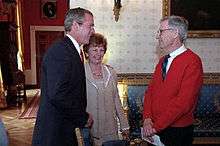
PBS funding
In 1969, Rogers appeared before the United States Senate Subcommittee on Communications. His goal was to support funding for PBS and the Corporation for Public Broadcasting, in response to proposed budget cuts. In about six minutes of testimony, Rogers spoke of the need for social and emotional education that public television provided. He argued that alternative television programming like his Neighborhood helped encourage children to become happy and productive citizens, sometimes opposing less positive messages in the media and in popular culture. He recited the lyrics to one of his songs.[44]
The chairman of the subcommittee, John O. Pastore, was not familiar with Rogers' work and was sometimes described as impatient. However, he reported that the testimony had given him goosebumps, and declared, "I think it's wonderful. Looks like you just earned the $20 million." The subsequent congressional appropriation, for 1971, increased PBS funding from $9 million to $22 million.[45]
VCR
During the controversy surrounding the introduction of the household VCR, Rogers was involved in supporting VCR manufacturers in court. His 1979 testimony, in the case Sony Corp. of America v. Universal City Studios, Inc., noted that he did not object to home recordings of his television programs by families in order to watch them together at a later time. His testimony contrasted with the views of others in the television industry who objected to home recording or believed that VCRs should be taxed or regulated.
When the case reached the Supreme Court in 1983, the majority decision considered the testimony of Rogers when it held that the Betamax video recorder did not infringe copyright. The court stated that his views were a notable piece of evidence "that many [television] producers are willing to allow private time-shifting to continue" and even quoted his testimony in a footnote:
Some public stations, as well as commercial stations, program the Neighborhood at hours when some children cannot use it ... I have always felt that with the advent of all of this new technology that allows people to tape the Neighborhood off-the-air, and I'm speaking for the Neighborhood because that's what I produce, that they then become much more active in the programming of their family's television life. Very frankly, I am opposed to people being programmed by others. My whole approach in broadcasting has always been "You are an important person just the way you are. You can make healthy decisions." Maybe I'm going on too long, but I just feel that anything that allows a person to be more active in the control of his or her life, in a healthy way, is important.[46]
Death and memorials
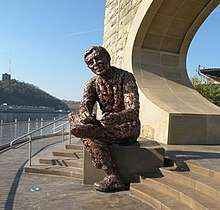
Rogers was diagnosed with stomach cancer in December 2002. He underwent surgery on January 6, 2003, which was unsuccessful.[8][47] A week earlier, he had served as grand marshal of the Tournament of Roses Parade, with Art Linkletter and Bill Cosby.[48]
Rogers died on the morning of February 27, 2003, at his home with his wife by his side, less than a month before he would have turned 75.[8][49] His death was such a significant event in Pittsburgh that most of the front page of the Pittsburgh Post-Gazette published the next day and an entire section of the paper devoted its coverage to him.[50] The Reverend William P. Barker presided over a public memorial in Pittsburgh. More than 2,700 people attended the memorial at Heinz Hall, including former Good Morning America host David Hartman; Teresa Heinz Kerry; philanthropist Elsie Hillman; PBS President Pat Mitchell; Arthur creator Marc Brown; and Eric Carle, the author-illustrator of The Very Hungry Caterpillar.[19] Speakers remembered Rogers's love of children, devotion to his religion, enthusiasm for music, and quirks. Teresa Heinz Kerry said of Rogers, "He never condescended, just invited us into his conversation. He spoke to us as the people we were, not as the people others wished we were."[51]
Rogers is interred at Unity Cemetery in Latrobe.[52]
At the 2003 Daytime Emmy Awards, host Wayne Brady and some of the cast of Sesame Street, including Big Bird, Elmo, Grover, Zoe, and Rosita, paid tribute to Rogers by singing a medley of some of his most popular songs, including "Won't You Be My Neighbor," "It's You I Like," "Everybody's Fancy," "Many Ways to Say I Love You," and "It's Such a Good Feeling." Once they finished, a small clip of Rogers accepting an Emmy was played, which led the audience to give a standing ovation.
In January 2018, it was announced that Tom Hanks would portray Rogers in an upcoming biographical film titled You Are My Friend directed by Marielle Heller.[53] That same year, the biodoc Won't You Be My Neighbor? based on the life and legacy of Rogers, was released to critical acclaim and became the highest grossing biodoc film of all time.[54]
Awards and honors
On New Year's Day 2004, Michael Keaton, who had been a stagehand on Mister Rogers' Neighborhood before becoming an actor, hosted the PBS TV special Fred Rogers: America's Favorite Neighbor. It was released on DVD on September 28 that year. In 2008, to mark what would have been his 80th birthday, Rogers' production company sponsored several events to memorialize him, including "Won't You Wear a Sweater Day", during which fans and neighbors were asked to wear their favorite sweaters in celebration.[55] The event takes place annually on his birth date, March 20.[56]
Rogers received the Ralph Lowell Award in 1975.[57] In 1987, he was initiated as an honorary member of Phi Mu Alpha Sinfonia Fraternity, the national fraternity for men of music.[58] The television industry honored Rogers with a George Foster Peabody Award "in recognition of 25 years of beautiful days in the neighborhood" in 1992;[59] previously, he had shared a Peabody award for Mister Rogers' Neighborhood in 1968. Rogers was a National Patron of Delta Omicron, an international professional music fraternity.[60] He was inducted into the Television Hall of Fame in 1999.[61] One of Rogers' iconic sweaters was acquired by the Smithsonian Institution, which displays it as a "Treasure of American History".[62] In 2002, Rogers received the PNC Commonwealth Award in Mass Communications.[63]
In 1991, the Pittsburgh Penguins named Rogers as their celebrity captain, as part of a celebration of the National Hockey League's 75th anniversary,[64] based on his connections to Pennsylvania and Pittsburgh. Card No. 297 from the 1992 NHL Pro Set Platinum collection commemorated the event, making Fred one of only twelve celebrity captains to be chosen for a sports card.[65]
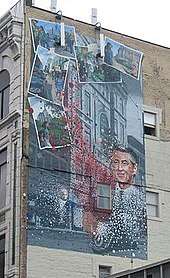
George W. Bush awarded Rogers the Presidential Medal of Freedom in 2002 for his contributions to children's education, saying that "Fred Rogers has proven that television can soothe the soul and nurture the spirit and teach the very young". A year later, the U.S. Senate unanimously passed Resolution 16 to commemorate the life of Fred Rogers.[2] It read, in part, "Through his spirituality and placid nature, Mr. Rogers was able to reach out to our nation's children and encourage each of them to understand the important role they play in their communities and as part of their families. More importantly, he did not shy away from dealing with difficult issues of death and divorce but rather encouraged children to express their emotions in a healthy, constructive manner, often providing a simple answer to life's hardships." Following Rogers' death, the U.S. House of Representatives in 2003 unanimously passed Resolution 111 honoring Rogers for "his legendary service to the improvement of the lives of children, his steadfast commitment to demonstrating the power of compassion, and his dedication to spreading kindness through example."[66]
The same year, the Presbyterian Church approved an overture "to observe a memorial time for the Reverend Fred M. Rogers" at its General Assembly.[67] The rationale for the recognition of Rogers reads, "The Reverend Fred Rogers, a member of the Presbytery of Pittsburgh, as host of Mister Rogers' Neighborhood since 1968, had a profound effect on the lives of millions of people across the country through his ministry to children and families. Mister Rogers promoted and supported Christian values in the public media with his demonstration of unconditional love. His ability to communicate with children and to help them understand and deal with difficult questions in their lives will be greatly missed."[68]
In 2003, the asteroid 26858 Misterrogers was named after Rogers by the International Astronomical Union in an announcement at the Carnegie Science Center in Pittsburgh. The science center worked with Rogers' Family Communications, Inc. to produce a planetarium show for preschoolers called "The Sky Above Mister Rogers' Neighborhood", which plays at planetariums across the United States.[69][70]
Several buildings, monuments, and works of art are dedicated to Rogers' memory, including a mural sponsored by the Pittsburgh-based Sprout Fund in 2006, "Interpretations of Oakland," by John Laidacker that featured Mr. Rogers.[71] Saint Vincent College in Latrobe, Pennsylvania, completed construction of The Fred M. Rogers Center for Early Learning and Children's Media in 2008.[72] The Fred Rogers Memorial Statue on the North Shore near Heinz Field in Pittsburgh[73] was created by Robert Berks and dedicated in 2009.[74] The statue was placed in front of the surviving footing of the Manchester Bridge, which was cleaned and carved out in order to place the statue there.
In 2015, players of the Altoona Curve, a Double-A affiliate of the Pittsburgh Pirates, honored Rogers by wearing special commemorative jerseys that featured a printed facsimile of his classic cardigan and tie ensemble. After the game the jerseys were auctioned off with the proceeds going to the local PBS station, WPSU-TV.[75]
On March 6, 2018, a primetime special commemorating the 50th anniversary of the series aired on PBS, hosted by actor Michael Keaton.[76] The hour-long special also features interviews by musician Yo-Yo Ma, musician Itzhak Perlman, actress Sarah Silverman, actress Whoopi Goldberg, actor John Lithgow, screenwriter Judd Apatow, actor David Newell, producer Ellen Doherty, and spouse Joanne Byrd Rogers, as well as clips of memorable moments from the show, such as Rogers visiting Koko the gorilla, Margaret Hamilton dressing up as The Wizard of Oz's Wicked Witch of the West, and Jeff Erlanger in his wheelchair singing It's You I Like with Rogers.[77]
Fred Rogers appeared on a commemorative US postage stamp in 2018. The stamp, showing him as Mister Rogers alongside King Friday XIII, was issued on March 23, 2018, in Pittsburgh.[78]
On September 21, 2018, Google Doodle honored him with a stop motion video of Mister Rogers' Neighborhood.[79]
Honorary degrees
- Thiel College, 1969[80]
- Eastern Michigan University, 1973[81]
- Saint Vincent College, 1973[81]
- Christian Theological Seminary, 1973[81]
- Rollins College, 1974[81]
- Yale University, 1974[82]
- University of Pittsburgh, 1976[81]
- Carnegie Mellon University, 1976[81]
- Lafayette College, 1977[81]
- Pittsburgh Theological Seminary, 1978[81]
- Waynesburg University, 1978[81]
- Linfield College, 1982[81]
- Slippery Rock State College, 1982[81]
- Duquesne University, 1982[81]
- Washington & Jefferson College,1984[81]
- University of South Carolina, 1985[81]
- Hobart and William Smith Colleges, 1985[81]
- Bowling Green State University, 1987[83]
- University of Connecticut, 1991[84]
- Boston University, 1992[85]
- West Virginia University, 1995[86]
- Edinboro University of Pennsylvania, 1998[87]
- Rider University, 1999[88]
- Marist College, 1999[89]
- Marquette University, 2001[90]
- Dartmouth College, 2002[91]
- Seton Hill University, 2003 (posthumous)[92]
- Union College, 2003 (posthumous)[93]
- Roanoke College, 2003 (posthumous)[91]
See also
- Won't You Be My Neighbor? – 2018 documentary about Rogers
- You Are My Friend – drama film to be released in October 2019
References
- ↑ John Donvan (February 2, 2018). "Mr Rogers ... Cool Dude" – via YouTube.
- 1 2 "Bill Text – 108th Congress (2003–2004) – S.CON.RES.16.ATS". THOMAS. Library of Congress. March 5, 2003. Archived from the original on July 18, 2012. Retrieved July 30, 2010.
- ↑ Sostek, Anya (November 6, 2009). "Mr. Rogers takes rightful place at riverside tribute". Pittsburgh Post-Gazette. Retrieved September 6, 2010.
- 1 2 Mister Rogers defending PBS to the US Senate (Video). Retrieved September 6, 2010.
- 1 2 3 4 DeFranceso, Joyce (April 2003). "Remembering Fred Rogers: A Life Well-Lived: A look back at Fred Rogers' life". Pittsburgh Magazine. Archived from the original on January 3, 2005. Retrieved July 30, 2010.
- ↑ "Special Collectors' Issue: 50 Greatest TV Stars of All Time". TV Guide (December 14–20, 1996). 1996.
- ↑ "Fred McFeely Rogers Historical – Latrobe – PA – US – Historical Marker Project".
- 1 2 3 Owen, Rob; Barbara Vancheri (February 28, 2003). "Fred Rogers dies at 74". Pittsburgh Post-Gazette. Retrieved July 30, 2010.
- ↑ Kimmel, Margaret Mary; Collins, Mark (September 2008). "The Wonder of It All: Fred Rogers and the Story of an Icon" (PDF). Retrieved March 20, 2018.
- ↑ "A Plane Crazy America". AOPA Pilot: 79. May 2014.
- ↑ Soichet, Aude; Valiente, Alexa; Donvan, John (June 7, 2018). "Mister Rogers' wife on how her husband would speak up against political leadership today". ABC News. Retrieved June 12, 2018.
- 1 2 "A beautiful day in the neighborhood: The Fred Rogers documentary is now showing in theaters". WTAE.com. June 8, 2018. Retrieved June 12, 2018.
- ↑ Comm, Joseph A. (February 2, 2015). Legendary Locals of Latrobe. Arcadia Publishing.
- ↑ Brownawell, Angel (February 28, 2003). "Neighborhood mourns Mister Rogers". Pittsburgh Tribune-Review. Retrieved July 30, 2010.
- ↑ "'Mister Rogers' to give Dartmouth Commencement Address". Dartmouth News. Dartmouth College Office of Public Affairs. May 2, 2002. Archived from the original on October 13, 2007. Retrieved July 30, 2010.
- ↑ Davis, Bobby (Summer 2003). "Fred McFeely Rogers". The Rollins Alumni Record. pp. 20–23. Archived from the original on July 20, 2011. Retrieved July 30, 2010.
- ↑ Vancheri, Barbara (December 25, 2003). "As promised, Joanne Rogers is doing 'fine'". Pittsburgh Post-Gazette. Archived from the original on December 22, 2017. Retrieved December 22, 2017.
- ↑ "Fred McFeely Rogers". UXL Newsmakers (2005). 2005. Archived from the original on September 24, 2008. Retrieved December 13, 2007 – via Find Articles.
- 1 2 3 Vancheri, Barbara; Owen, Rob (May 4, 2003). "Pittsburgh bids farewell to Fred Rogers with moving public tribute". Pittsburgh Post-Gazette. Retrieved July 30, 2010.
- 1 2 3 "Terry Gross and Fred Rogers". Fresh Air with Terry Gross. NPR. February 28, 2003. Retrieved September 29, 2016. Show originally aired 1985
- ↑ Rodgers-Melnick, Ann (May 4, 2003). "Liberal pastor retires after long run in city". Pittsburgh Post-Gazette. Retrieved July 30, 2010.
- 1 2 3 Junod, Tom (November 1998). "Can You Say ... 'Hero'?". Esquire. Archived from the original on March 1, 2003. Retrieved July 30, 2010.
- ↑ Roddy, Dennis (March 1, 2003). "Fred Rogers kept it simple, and elegantly so". Pittsburgh Post-Gazette. Retrieved December 12, 2007.
- 1 2 Millman, Joyce (August 10, 1999). "Salon Brilliant Careers: Fred Rogers". Salon. Archived from the original on December 18, 2010. Retrieved July 30, 2010.
- ↑ Long, Michael (November 21, 2014). "What Would Mr. Rogers Eat? Thanksgiving in the Neighborhood". HuffPost. Retrieved November 7, 2016.
- ↑ Emery, David (November 26, 2011). "Mr. Rogers Was a Marine Sniper / Navy SEAL?". urbanlegends.about.com. Retrieved December 22, 2011.
- ↑ "Mr. Rogers Was a Sniper in Vietnam – Fiction!". Truthorfiction.com. Retrieved December 22, 2011.
- ↑ "Won't You Be My Fiend?". snopes.com. August 7, 2007. Retrieved December 22, 2011.
- ↑ "The Pittsburgh Press" – via Google News Archive Search.
- ↑ Kaufman, Amy. "Fred Rogers' family keeps the legacy of 'Mister Rogers' Neighborhood' alive with a candid new documentary". Los Angeles Times. Retrieved August 2, 2018.
- ↑ Obis, Paul (November 1983). "America's Favorite Neighbor". Vegetarian Times. pp. 22–26.
- ↑ Tiech, John (July 17, 2012). Pittsburgh Film History: On Set in the Steel City. Arcadia Publishing.
- ↑ Schultz, Mike. "Sylvania Award". uv201.com. Retrieved July 30, 2010.
- ↑ "Fred Rogers Biography".
- ↑ Williams, Suzanne. "Fred McFeely Rogers". museum.tv. The Museum of Broadcast Communications. Retrieved July 30, 2010.
- ↑ "Fred Rogers".
- ↑ Owen, Rob (November 12, 2000). "There goes the Neighborhood: Mister Rogers will make last episodes of show in December". Pittsburgh Post-Gazette Magazine. Retrieved March 20, 2011.
- ↑ Edwards, Joe (May 21, 1984). "Burger King ad strategy pushes unit volumes near $1M". Nation's Restaurant News. Archived from the original on July 8, 2012. Retrieved May 16, 2009.
- ↑ Dougherty, Philip (May 10, 1984). ADVERTISING; Thompson Withdraws An Ad for Burger King, The New York Times. Retrieved January 11, 2011.
- ↑ "Fred Rogers Interview Part 9 of 9". Retrieved June 16, 2013.
- ↑ Fred Rogers – Voice Actor Profile at Voice Chasers. Retrieved October 19, 2012
- ↑ Video on YouTube
- ↑ "Fred Rogers Acceptance Speech – 1997" on YouTube Official Emmys channel. March 26, 2008. Retrieved Mar 10, 2011.
- ↑ "Mister Rogers defending PBS to the US Senate". June 29, 2007. Retrieved September 1, 2016 – via YouTube.
- ↑ "Fred Rogers Beyond the Neighborhood: Senate Committee Hearing". Fred Rogers Center. 1969. Archived from the original on June 17, 2012. Retrieved May 27, 2014.
- ↑ "Sony Corp. of America v. Universal City Studios, Inc., 464 U.S. 417 (1984)". Supreme Court of the United States of America. 1984. Retrieved July 30, 2010.
- ↑ Everhart, Karen (March 10, 2003). "Fred Rogers, 1928–2003". Current. Archived from the original on June 17, 2011. Retrieved July 30, 2010.
- ↑ "Grand Marshal Slide Show Main". Tournament of Roses. 2004. Archived from the original on November 11, 2006. Retrieved February 26, 2010.
- ↑ Lewis, Daniel (February 28, 2003). Fred Rogers, Host of 'Mister Rogers' Neighborhood,' Dies at 74, The New York Times. Retrieved January 9, 2011.
- ↑ "Fred Rogers dies". Pittsburgh Post-Gazette – via Google News Archive Search.
- ↑ Vancheri, Barbara (May 4, 2003). Pittsburgh bids farewell to Fred Rogers with moving public tribute, Pittsburgh Post-Gazette. Retrieved January 9, 2011.
- ↑ The Good Neighbor
- ↑ "Soulful, Inspiring Mister Rogers Movie Trailer Just Might Make You Cry". Vanity Fair. March 20, 2018. Retrieved March 20, 2018.
- ↑ "Won't You Be My Neighborhood Is the Top Grossing Biodoc of All Time". The Hollywood Reporter. July 27, 2018.
- ↑ "Won't You Wear a Sweater?". Rollins News Center. Rollins College. March 21, 2008. Archived from the original on June 9, 2010. Retrieved July 30, 2010.
- ↑ "Wear a sweater, honor Mr. Rogers". Today. February 27, 2008. Retrieved July 19, 2016.
- ↑ Silva, P (July 20, 2015). "Ralph Lowell Award".
- ↑ Faith Spicer, Cheri (May 2004). "Remembering Our Neighbor: His Lessons on Listening and Love" (PDF). The Sinfonian. sinfonia.org. pp. 19–21. Archived from the original (PDF) on August 29, 2010. Retrieved July 30, 2010.
- ↑ "George Foster Peabody Award Winners". University of Georgia, George Foster Peabody Award.
- ↑ "National Patrons & Patronesses". Delta Omicron. Archived from the original on March 17, 2008. Retrieved July 30, 2010.
- ↑ "Hall of Fame". Academy of Television Arts & Sciences. Archived from the original on December 16, 2008. Retrieved December 3, 2008.
- ↑ "NMAH – Treasures of American History – American Television (page 2 of 2)". National Museum of American History. Smithsonian Institution. Retrieved July 30, 2010.
- ↑ PNC Honors Six Achievers Who Enrich The World, PNC Financial Services Group (2002). Retrieved January 9, 2011.
- ↑ "Can you say ... captain?". Pittsburgh Post-Gazette. 65 (58). October 7, 1991. p. 1. Retrieved February 1, 2017.
- ↑ "Mister Rogers' Hockey Card". Puck Junk. Retrieved February 1, 2017.
- ↑ "Bill Text – 108th Congress (2003–2004) – H.RES.111.EH". THOMAS. Library of Congress. March 4, 2003. Retrieved July 30, 2010.
- ↑ "Recommendations on Business before the 215th General Assembly". General Assembly of the Presbyterian Church. 2003. Archived from the original on July 19, 2011. Retrieved July 30, 2010.
- ↑ "Minutes: 215th General Assembly (2003), Part I" Archived July 22, 2011, at the Wayback Machine., Office of the General Assembly, Proceedings of the 215th General Assembly (2003) of the Presbyterian Church, p. 107. Retrieved January 9, 2011.
- ↑ 26858 Misterrogers (1993 FR), NASA. Retrieved January 9, 2011.
- ↑ Plunkett, Chuck (May 2, 2003). Mister Rogers' star status now reaches heavenly proportions Archived March 16, 2012, at the Wayback Machine., Pittsburgh Tribune Review. Retrieved January 9, 2011.
- ↑ "2006 Sprout Public Art Mural Kickoff Event Schedule". thisishappening. Archived from the original on July 17, 2011. Retrieved July 30, 2010.
- ↑ "Fred M. Rogers Center". Saint Vincent College. 2010. Archived from the original on July 16, 2011. Retrieved July 30, 2010.
- ↑ Sostek, Anya (November 5, 2009). "Sculpture of Fred Rogers unveiled on North Side". Pittsburgh Post-Gazette. Retrieved November 9, 2009.
- ↑ Butter, Bob (November 5, 2009). "World's First Sculpture of American Icon Fred Rogers Unveiled". Reuters. Archived from the original on February 1, 2013. Retrieved November 5, 2009.
- ↑ Maloy, Brendan (June 11, 2015). "Minor league team honors Mr. Rogers with cardigan uniforms". Sports Illustrated. Retrieved January 23, 2017.
- ↑ Hinckley, David (March 3, 2018). "Mister Rogers has become 'one of the coolest men on the planet'". Daily News. New York. Retrieved March 5, 2018.
- ↑ "5 ways to celebrate 'Mister Rogers' Neighborhood' on its 50th anniversary". USA Today. Retrieved March 8, 2018.
- ↑ U.S. Postal Service Provides First-Day Date and Locations for 2018 First Quarter Stamp Issuances, US Postal Service news release, December 19, 2017
- ↑ https://www.youtube.com/watch?v=Rd7X0NsOeRk
- ↑ Erdley, Debra. "Thiel College remembers Mister Rogers". TribLIVE.com. Retrieved August 3, 2018.
- 1 2 3 4 5 6 7 8 9 10 11 12 13 14 15 "Honorary Degrees Awarded to Fred Rogers".
- ↑ "Music student pens Mister Rogers score". Yale Daily News. Retrieved August 3, 2018.
- ↑ "Readers: Goodbye Mister Rogers". Cincinnati Enquirer. Retrieved August 3, 2018.
- ↑ "Honorary Degree Recipients - 1990s | Honorary Degrees". honorarydegree.uconn.edu. Retrieved August 3, 2018.
- ↑ "Honorary Degree Recipients of the Past 25 Years" (PDF).
- ↑ "W.V. UNIVERSITY TO HONOR A NEIGHBOR: MR. ROGERS". Deseret News. April 6, 1995. Retrieved August 3, 2018.
- ↑ "Pa. Physician General, nearly 800 EU students receive degrees - Edinboro University". edinboro.edu. Retrieved August 3, 2018.
- ↑ "Honorary Degree Recipients". Rider University. August 27, 2010. Retrieved August 3, 2018.
- ↑ "Commencement; Fordham Class Hears Magician and Peacemaker". Retrieved August 3, 2018.
- ↑ "Fred Rogers". University Honors | Marquette University. Retrieved August 2, 2018.
- 1 2 "Academic Hood Quilt". The Fred Rogers Center. Retrieved 2018-10-02.
- ↑ "Seton Hall Will Have Tribute to Rogers". Huron Daily Tribune. April 17, 2003. Retrieved August 3, 2018.
- ↑ "Joanne Rogers accepts husband's 41st honorary degree". Union College News Archives. June 15, 2003. Retrieved August 3, 2018.
External links
| Wikimedia Commons has media related to Fred Rogers. |
| Wikiquote has quotations related to: Fred Rogers |
- Fred Rogers on IMDb
- PBS Kids: Official Site
- The Fred M. Rogers Center
- The Fred Rogers Company (formerly known as Family Communications)
- Fred Rogers at The Interviews: An Oral History of Television
- "It's a Beautiful 50th Birthday for 'Mister Rogers' Neighborhood'". Fresh Air. NPR. February 19, 2018. 1984 interview with Fred Rogers.
- The Music of Mister Rogers – Pittsburgh Music History
- Fred Rogers at Voice Chasers
- Appearances on C-SPAN